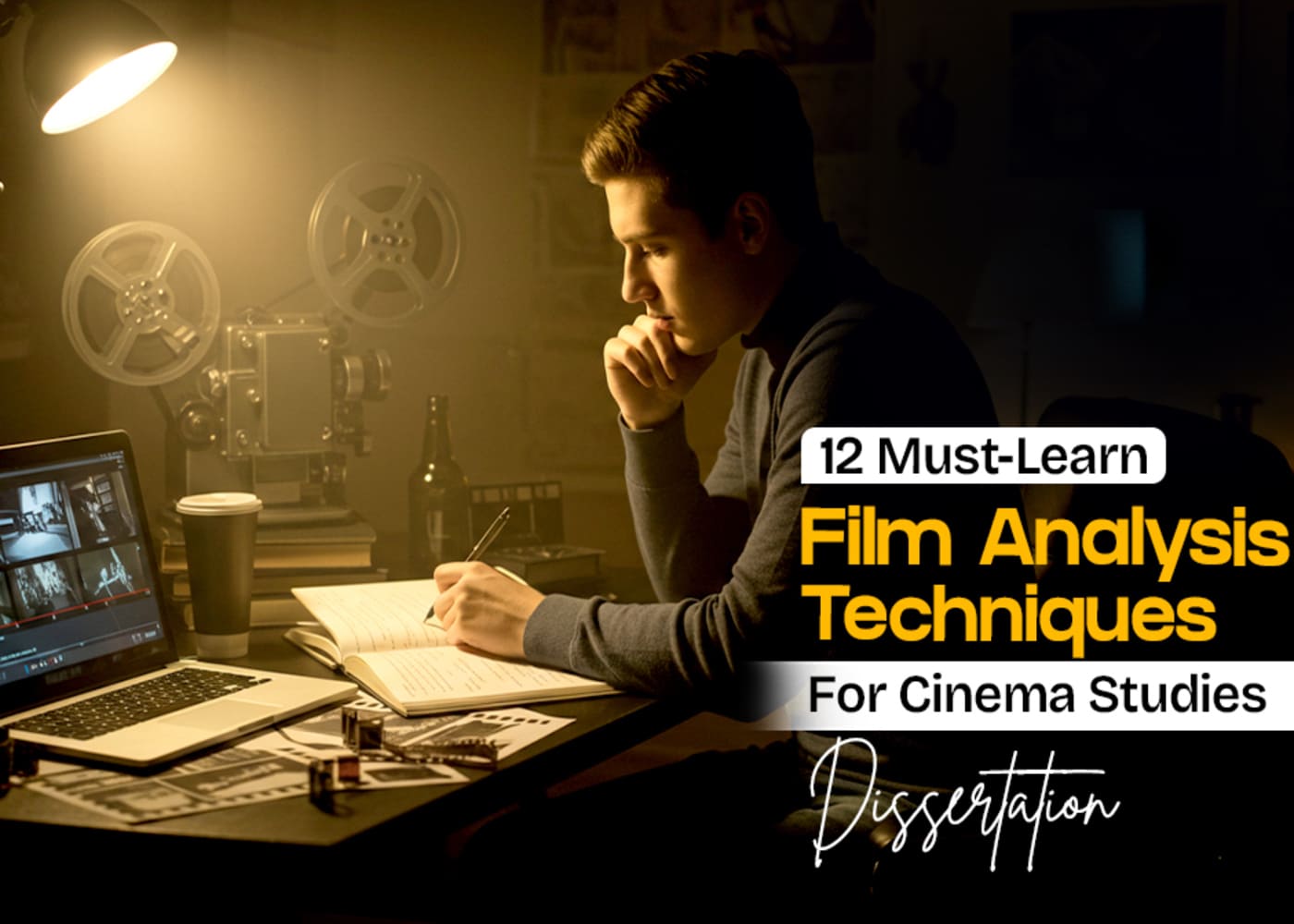Want to make your cinema studies dissertation stand out? Read this article to explore 12 film analysis techniques that will help you research better and bring stronger critical insights to your work.
Learning film analysis techniques can be the key to writing a powerful cinema studies dissertation because film is more than just entertainment. It reflects culture, history, and human experience. Studying cinema at an academic level trains you to look beyond the surface and think more critically about the stories, visuals, and ideas that shape films.
According to a study of the University of North Caroline, film analysis trains you to see the techniques, choices, and theories that shape what appears on screen. Film analysis is the backbone of cinema studies. Without analysis, films would remain mere entertainment. Your dissertation in cinema studies will depend on how deeply you can analyse films. In this piece of writing, we will discuss the top twelve essential film analysis techniques, each of which will open a different door into cinema.
Important Details Discussed!
Here is what you need to know
Film analysis helps the students gain clear tools to research meaning, style and reader impression.
Understanding of the various film analysis techniques enriches and enhances the quality of dissertations.
The visuals help in learning about cinematography, the use of colours, and mise-en-scène.
Narrative analysis highlights plot structure, themes, and storytelling patterns.
Reception and cultural analyses are audience-centred theories that demonstrate the influence of viewers on meaning.
The auteur theory relates how a director does his work to repetitive concepts in the movies.
Importance of Film Analysis in Academic Research
The approach in the research on film will enable you to turn your own viewing experience into a structured analysis. In research, analysis shows how films create meaning through technical and visual narrative choices. By analysing a film, you engage with history, theory and culture.
A cinema studies dissertation requires evidence. Film analysis fulfils the needs of evidence. Each angle, sound, cut or colour scheme is turned into a piece of data. You can make use of it in support of your argument. Your dissertation becomes vague or opinion-based when you skip analysis.
Cinema studies as an academic field are concerned with in-depth research. It also upholds clarity. Analysis of movies enables you not only to say what a film represents, but how it represents it and why it matters.
How Film Analysis Shapes Your Cinema Studies Dissertation?
A dissertation in cinema studies is more than writing a long story. It is an academic study that reflects your critical thinking capacity regarding film. The film analysis technique shapes each chapter of this process.
When you choose a film, you have to decide which aspects to study. The possible choices are:
Narrative
Cinematography
Editing
Sound and Ideology
The methods of analysis will guide your work. For instance, if you write about gender representation, feminist film theory becomes central theme. If you explore class conflict, Marxist film analysis shapes your approach.
Film analysis also shapes your argument. You never make blanket statements; instead, you give fine details. You need to explain how editing shifts the perception of the audience. This depth will give strength to your dissertation and provide an academic tone.
Writing a cinema studies dissertation demands more than just film knowledge. It requires structured arguments, expert analysis, and accurate referencing. Applying theories like narrative study and film source citation often becomes a major challenge for students. Such students hire UK-based dissertation writing services. Experts at The Academic Papers UK provide error-free writing and properly referenced work that adds strength and credibility to your dissertation.
Why Mastering Film Analysis Techniques is Essential for a Cinema Studies Dissertation
Learning film analysis skills is not optional; it is necessary for cinema studies disseration. More than a plot summary will be required in your cinema studies thesis. It will demand that you analyse, evaluate and relate the movies to outside conceptions.
The use of film analysis strengthens your skills as a researcher. While many students may write about the same films, what makes your dissertation unique is the way you approach their analysis. By mastering different techniques, you gain the flexibility to apply various strategies and build a powerful, original argument.
Above all, the film genre analysis technique makes your dissertation convincing. Professors and examiners seek informed and structured arguments. They value dissertations that demonstrate both technical expertise and strong theoretical insight.
The 12 Must-Learn Film Analysis Techniques for Cinema Studies Dissertation
A strong cinema studies dissertation goes beyond watching films. The following 12 film analysis techniques guide students in exploring movies with academic depth and precision.
1: Narrative Analysis
The narrative structure analysis is based on a story. You need to learn the story presentation. Is it linear or non-linear? Does it have a three-act structure? In what way does the film go about conflict and resolution?
Knowledge of structure provides you with a clue to pacing and tension. It also helps you determine turning points that shape character journeys.
Identifying Plot, Themes, and Character Arcs
Themes are a fundamental factor in film narrative analysis. For example, a film's story is mostly based on love, power, justice, identity, or survival. You should pick out these themes and speak of how the plot supports them.
Another major component is character arcs. What happens to the protagonist? What challenges condition their transformations? In a good cinema studies dissertation, the character development reflects wider social or cultural concerns.
For example, a diagram of a character arc is mentioned below. It indicates how a character transforms from one situation to another.
Resource: Research Gate
2 Mise-en-Scène Analysis
Mise-en-scène analysis is everything in the frame. It includes sets, props, costumes, and actors. It defines the visual content of the movie.
You should study composition. In what way are the objects placed in the frame? Does it have symmetry, or is it disorderly? The use of symbols is usually hidden in visual facts. A simple, inexpensive item, such as a broken mirror, can carry profound meaning.
Lighting, Colour Palette, and Costume Design
Lighting shapes mood. When light is bright, it can suggest openness. The shadows can resemble danger. Colour palettes also create emotional effects. Stress on warm colours can be a suggestion of comfort. Cold colours can convey isolation.
The costume design is also very relevant. In the dissertation topic, clothes indicate a class, character or change. A change of costume is sometimes an indication of a turning point in a character’s journey.
3: Cinematography Analysis
Analysing cinematography is like learning the language of the camera. Every shot has a purpose. Close-ups highlight emotion, while wide shots show the context. High angles can make characters seem vulnerable, and low angles can make them appear powerful. Camera movement also shapes the story. A slow pan can build suspense, and a handheld shot can make a character feel real and immediate.
Role of Framing in Storytelling
Framing determines the perception of the audience. It determines what is hidden. Such selection defines interpretation. A character placed at the edge of the frame may suggest isolation. A closed framing can be tensed or have the feeling of claustrophobia.
4: Editing and Montage Analysis
Editing has controlled Rhythm and flow. Continuity editing is an attempt to pursue smooth narration. Non-linear editing is an obstacle that flows and makes the audience question time and perspective.
Employment of Cuts, Transitions and Pacing
Cuts create rhythm in a film. Fast cuts generate energy, while slow cuts create calm. Fades and dissolves signal change and indicate transitions. In a strong cinema studies dissertation, pacing becomes crucial, as it influences how long an audience engages with a scene and shapes their emotional response.
5: Sound and Music Analysis
Sound introduces an additional meaning. Diegetic sound is found in the film world. Non-diegetic sound is external, like background music. Examination of these decisions indicates how sound brings about the shaping of realism or mood.
Emotional Impact of Film Scores
Music allows directing the emotion more than visual storytelling analysis. A simple scene may appear threatening because it has a suspenseful score. It may also be the power of silence. The analysis of soundtracks can show the impact of music that creates interest among the viewers.
6: Genre Analysis
All film genre analysis has conventions. Horror uses darkness and stress. Comedy uses time and magnification. Genre analysis looks at how films use or break these rules. It also explains why audiences enjoy familiar patterns. This study teaches students to analyse the way genres control meaning and how they determine audience response.
Sub-Genre or Hybrid Interpretation
A lot of movies combine genres. A comedy can have drama in it as well. Science fiction may also be incorporated into the horror film. The study of hybrids indicates the filmmakers' innovative approach.
7: Auteur Theory Analysis
The auteur theory regards the director as the principal author of a movie. One has to learn the characteristic themes, styles or visual motifs of a director. The approach reveals the influence of a director's vision on the narrative. It also helps students connect films with the sense of personal voice and identity of the filmmaker.
How the Filmmaker’s Vision Shapes the Narrative
Directors leave their mark on storytelling. The movie is based on the view of the world, its politics, and aesthetics. Auteur film analysis connects a film with the career of its creator.
8: Psychoanalytic Film Theory
Psychoanalysis is concerned with the unconscious. In film, it means hidden fears, desires and symbols. You have to look for pictures which is connected with these deeper psychological truths.
Freudian and Lacanian Interpretations
Psychoanalysis, as popularised by Freud, usually concerns repression, sexuality and desire. Lacanian analysis concerns itself with identity and the mirror stage. With the help of these film theories, you can research which form of inner conflict films follow.
9:Feminist Film Theory
Feminist film theory is considered one of the finest techniques of film analysis. Feminist film theory is the analysis of gender representations in film. It examines the issues of stereotype, power and equality. The question you should ask is: how are women portrayed? What is the setup of men? What are the power arrangements on-screen?
Critique of the Male Gaze in Cinema
The male gaze shows how films often present women through the lens of male desire. A strong dissertation topic is to critique this idea and study how it shapes the view of both genders. This approach helps us understand gender bias in cinema and reveals how men and women are portrayed differently on screen.
10: Marxist Film Analysis
Marxist film analysis technique focuses on class and power. In films, there is a trend of economic struggle. You will need to learn how working-class and ruling-class characters are depicted. Inequality and social conflict are also shown in this approach. It helps students understand how films represent or question power structures in the real world.
Description of Social Inequality
Inequality is revealed in many films. A Marxist reading shows how cinema reflects or challenges capitalist structures. It examines issues facing the marginalised. It examines the struggles of marginalised groups.
It also shows how money and status influence the lives of characters. This study unveils the power in stories. It makes the students realise how films can be used as ideology and instruments of opposition.
11: Semiotic Analysis
There is a semiotic film analysis of signs in films. Symbolism, gestures, and cultural codes are the tools that directors build a further meaning. Trust could be displayed in a handshake.
A broken mirror may be a sign of conflict. These viewers decoded these signs to realise the inner depths of the message passed on through the film.
Readings Through the Spatial Strata
Semiotics analysis makes one read between the lines. A red rose can be romantic, and a red rose can be dangerous as well. The meanings are culture and context-related. You must question what images truly suggest. This method makes you realise how movies convey a complicated message using basic visual content. The following pictures denote the strata in language.
Resource: Research Gate
12: Reception Theory Analysis
The reception theory focuses on the audience. The meaning of a film emerges as people view the film. Viewers bring their personal opinions, feelings and experiences. One viewer may see hope, another may see despair. The meaning of the message in the film changes because audiences shape its meaning through interpretation.
Cross-Cultural Reception of Films
The Reception theory shows the formation of culture through meaning. The majority of viewers of various backgrounds react differently. A joke can be funny in one culture and confusing in another culture. A political story might bring pride to a given nation and anger to the other one. Cultural values determine how audiences consider and perceive films.
How to Apply These Film Analysis Techniques in Your Cinema Studies Dissertation
Structure is important when it comes to doing your dissertation. It is possible to separate chapters into film analysis techniques. For example, narrative and mise-en-scène can be discussed in one of the chapters. Another chapter may focus on sound and editing.
A combination of several techniques often gives a richer analysis. For instance, analysis of a film, through both a feminist theory and semiotics, can lead to the interpretation of gender roles, as well as layers of symbolism.
Maintain consistency in your analytical strategies. If you begin with narration, connect it to the other methods you use later. This approach creates coherence in your arguments instead of presenting them as separate entity.
Common Mistakes to Avoid When Analysing Films
When you are going to analyse a film, you must avoid committing the following mistakes.
Do not overgeneralise themes. Be specific.
Do not ignore technical aspects. Sound, editing, and lighting matter.
Do not neglect historical and cultural context. A film means more when placed in its time.
Tools and Resources for Effective Film Analysis
Here are several tools and resources mentioned below, which are very effective in film analysis.
Academic Journals: Use journals such as Screen and Film Quarterly.
Research Databases: JSTOR, Project MUSE, and Google Scholar provide access to sources.
Video Editing Tools: Use video editing tools, such as Adobe Premiere, to break down the scenes.
Books related to Film Theory: Include the important works on film theory; notable works include those by Laura Mulvey, Christian Metz, and David Bordwell.
How Academic Helpers Can Assist With Cinema Studies Dissertations?
While writing a Cinema studies dissertation, students face various kinds of difficulties, like coherence in argument, a lack of critical analysis and a poor understanding of the crux of the main idea. In this situation, top-rated dissertation writing agencies, for example, Dissertation Writing UK and Cheap Essay Wriitng UK can assist the students. Their expert writer provides the following help with your cinema studies dissertation.
Editing and proofreading bring the finer touches into the cinema studies dissertation. Minor mistakes may undermine the work. Editing rectifies grammar, spelling and style. Proofreading will make it clear and precise. With expert support, the writing looks professional and academic.
Assistance in citing and referencing film material relieves time and effort. Many students cannot deal with reference rules. Errors in times and dates can influence grades. Professional assistance guarantees that all sources are formatted according to the appropriate style. This helps to establish credibility and also prevents any plagiarism..
Conclusion
The essence of the cinema study is film analysis. It converts films into writing that exposes culture, politics, psychology and art. Learning twelve techniques allows you to be ready to create a powerful dissertation. The various techniques provide access to distinct windows into the film.
A narrative, mise-en-scene, cinematography, editing, sound, genre, auteur theory, psychoanalysis, feminism, Marxism, semiotics and reception theory allow a dissertation to become powerful. It leaves the field of description and of critical interpretation. With appropriate tools, materials, and advice, you can work on a dissertation that will make an impression in the field of cinema studies.
FAQs
Why Should Students learn Film Analysis?
Film analysis must also be taught to students, as they will be able to comprehend the art of cinema rather than as a form of entertainment. It teaches them to learn semantics, pictures, and narration. The analysis of films requires sharp observation and critical thinking. It enhances research and academic writing as well.
Students are able to associate the films with culture, history, and society. Such a method equips them to take further studies in cinema and media. The study of film will enable them to develop powerful arguments and use clear knowledge in their dissertations.
Which Tools Are Used for Film Analysis?
Several tools exist for film analysis for students to study movies in detail.
With visual analysis, they can notice the use of the camera, lighting and colour. Story, characters and themes are the subjects of narrative analysis.






